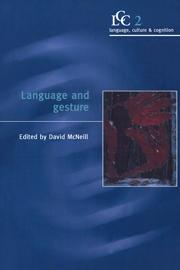Book contents
- Frontmatter
- Contents
- Acknowledgments
- Introduction
- Part 1 Gesture in action
- 1 Pointing, gesture spaces, and mental maps
- 2 Language and gesture: unity or duality?
- 3 The influence of addressee location on spatial language and representational gestures of direction
- 4 Gesture, aphasia, and interaction
- 5 Gestural interaction between the instructor and the learner in origami instruction
- 6 Gestures, knowledge, and the world
- Part 2 Gesture in thought
- Part 3 Modeling gesture performance
- Part 4 From gesture to sign
- Index
3 - The influence of addressee location on spatial language and representational gestures of direction
Published online by Cambridge University Press: 07 January 2010
- Frontmatter
- Contents
- Acknowledgments
- Introduction
- Part 1 Gesture in action
- 1 Pointing, gesture spaces, and mental maps
- 2 Language and gesture: unity or duality?
- 3 The influence of addressee location on spatial language and representational gestures of direction
- 4 Gesture, aphasia, and interaction
- 5 Gestural interaction between the instructor and the learner in origami instruction
- 6 Gestures, knowledge, and the world
- Part 2 Gesture in thought
- Part 3 Modeling gesture performance
- Part 4 From gesture to sign
- Index
Summary
Introduction
How do speakers refer to their experiences of spatial relations? Verbal language is one modality through which we can express spatial relations. However, speakers' expressions of spatial relations are not limited to those of the verbal modality but are often accompanied by so-called ‘iconic’ or ‘representational’ gestures (McNeill 1992; Kendon 1980). For example, when a speaker is expressing a motion upwards, she can say “the cat climbed up the drainpipe” and move her hand upwards to represent the direction of a cat's motion upwards during her utterance. If this is the case, then we have to understand speakers' use of representational gestures along with their use of spatial language in order to understand how speakers refer to spatial relations.
One way to understand spatial reference by spatial language and gestures is to assume that speakers' verbal and gestural expressions of space represent or encode the spatial relations as experienced. That is, there is a one-to-one coding relationship between the linguistic form and the representational gestures on the one hand and preexisting spatial experiences on the other. For example, some researchers argue that representational gestures derive from spatially encoded knowledge and help conceptualize the spatial relations that will be expressed in speech (Rauscher, Krauss & Chen 1996).
However, in this chapter I am going to argue and show empirically that speakers' verbal and gestural expressions of space, and specifically those of direction, cannot simply be explained by a one-to-one coding relationship between these expressions and the preexisting world of spatially encoded knowledge.
- Type
- Chapter
- Information
- Language and Gesture , pp. 64 - 83Publisher: Cambridge University PressPrint publication year: 2000
- 16
- Cited by



